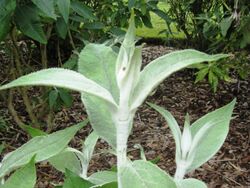Biology:Buddleja nivea
| Buddleja nivea | |
|---|---|

| |
| Buddleja nivea foliage | |
| Scientific classification | |
| Kingdom: | Plantae |
| Clade: | Tracheophytes |
| Clade: | Angiosperms |
| Clade: | Eudicots |
| Clade: | Asterids |
| Order: | Lamiales |
| Family: | Scrophulariaceae |
| Genus: | Buddleja |
| Species: | B. nivea
|
| Binomial name | |
| Buddleja nivea Duthie
| |
| Synonyms | |
| |
Buddleja nivea is a vigorous shrub endemic to western China , evergreen in the wild, but deciduous in cultivation in the UK. The plant was discovered by Wilson in the Yangtze basin at altitudes of 700 – 3,600 m. Introduced to cultivation in 1901, it was named by Duthie in 1905.[1][2] Several plants similar to the species but originally treated as species and varieties in their own right have now been sunk as B. nivea (see synonyms).[3]
Description
Buddleja nivea reaches 1–3 m high, and is chiefly distinguished by the dense white indumentum covering the branchlets, calyxes, and undersides of the leaves. The lanceolate leaves are of variable size, 6–22 cm long by 1.5–11 cm wide; they are acute or acuminate at the apex, rounded at the base, and very coarsely toothed except at the apex. The insignificant, faintly-scented flowers have short corollas 6–8 mm long, with only the erect lobes visible above the indumentum. The flowers range in colour from pink to purple, and are arranged as narrow terminal panicles, < 25 cm long, appearing in summer.[4] B. nivea is generally hexaploid (chromosome number 2n = 114), although plants identified as B. macrostachya may be hexaploid or dodecaploid (2n=228).[5]
Cultivation
The species is fairly common in cultivation in the UK as it is hardy to −15 °C. A large specimen is grown as part of the NCCPG National Collection held by Longstock Park Nursery near Stockbridge, Hampshire. Hardiness: USDA zones 7–8.[2]
References
- ↑ Bean, W. J. (1970). Trees & Shrubs Hardy in the British Isles, 8th ed., Vol. 1. (2nd impression 1976) London
- ↑ 2.0 2.1 Stuart, D. (2006). Buddlejas. RHS Plant Collector Guide. Timber Press, Oregon, USA. ISBN:978-0-88192-688-0
- ↑ Li, P. T. & Leeuwenberg, A. J. M. (1996). Loganiaceae, in Wu, Z. & Raven, P. (eds) Flora of China, Vol. 15. Science Press, Beijing, and Missouri Botanical Garden Press, St. Louis, USA. ISBN:978-0-915279-37-1 vol. 15 (1996): online at www.efloras.org
- ↑ Leeuwenberg, A. J. M. (1979) The Loganiaceae of Africa XVIII Buddleja L. II, Revision of the African & Asiatic species. H. Veenman & Zonen, Wageningen, Nederland.
- ↑ Chen, G, Sun, W-B, & Sun, H. (2007). Ploidy variation in Buddleja L. (Buddlejaceae) in the Sino-Himalayan region and its biogeographical implications. Botanical Journal of the Linnean Society. 2007, 154, 305–312. The Linnean Society of London.
Literature
| Wikimedia Commons has media related to Buddleja nivea. |
- Duthie, J. F. (1905). Gard. Chron. ser. 3.38 : 275.
- Hillier & Sons. (1990), Hilliers' Manual of Trees & Shrubs, 5th ed. (1990). David & Charles, Newton Abbot.
- Krüssmann, G. (1984). Manual of Cultivated Broad-leaved Trees & Shrubs, Vol. 1. Engl. transl. London, 1984.
- Li, P. T. & Leeuwenberg, A. J. M. (1996). Loganiaceae, in Wu, Z. & Raven, P. (eds) Flora of China, Vol. 15. Science Press, Beijing, and Missouri Botanical Garden Press, St. Louis, USA. ISBN:978-0915279371 online at www.efloras.org
- Phillips, R. & Rix, M. (1989). Shrubs, Pan Books, London. ISBN:0-330-30258-2
Wikidata ☰ Q4984695 entry
 |


